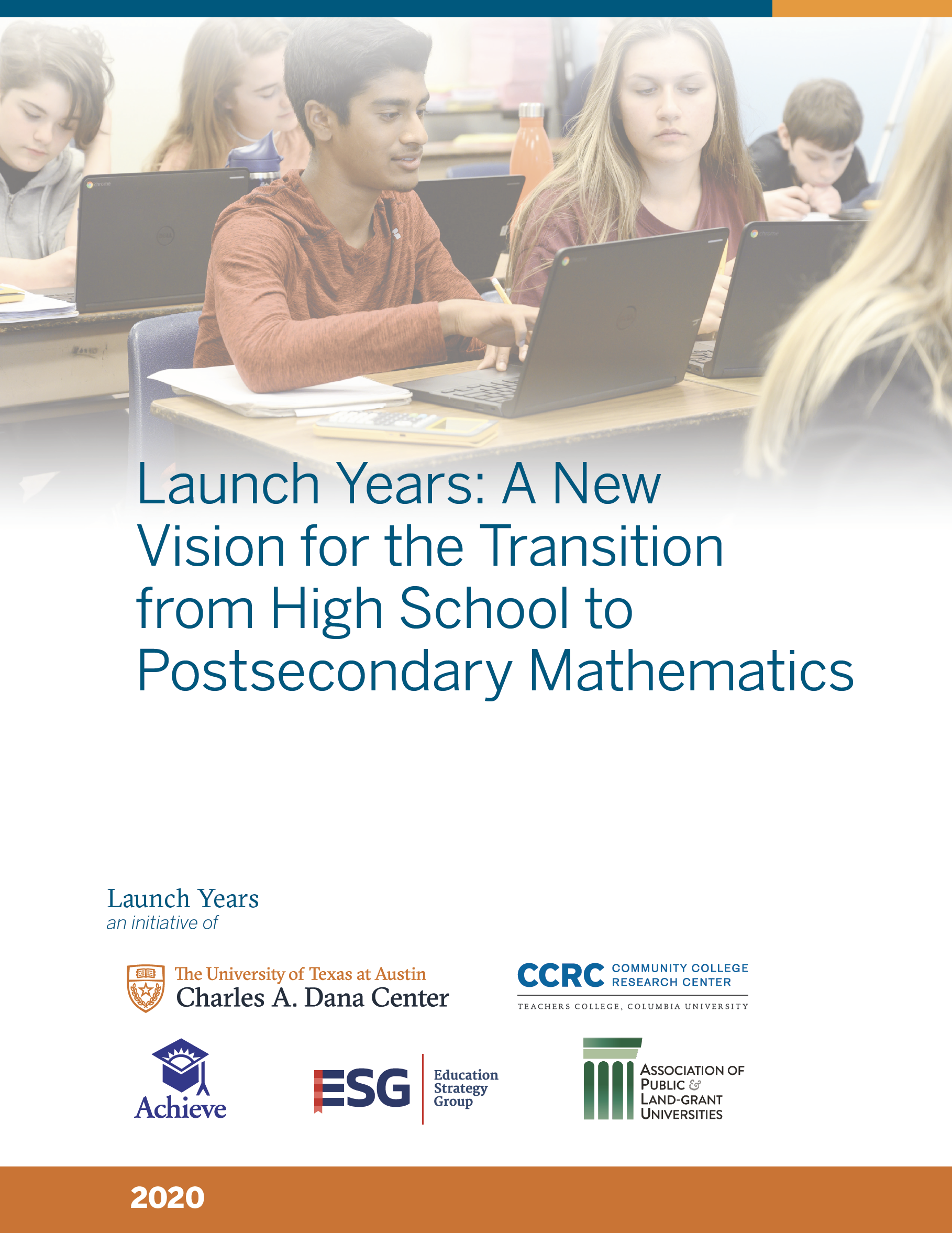
Great Ideas Aren’t Enough: Lessons for Launch Years Implementation
This blog is part of a series exploring the Launch Years report recommendations.
The newly released report Launch Years: A New Vision for the Transition from High School to Postsecondary Mathematics presents seven recommendations for improving opportunities for students as they transition from high school to postsecondary mathematics and the workforce.
Launch Years Recommendation 6: State agencies and education systems, institutions, and schools build a strong shared understanding of—and commitment to—goals among their constituents.
Making Your Great Idea A Reality
Releasing a report to the field is a proud moment. Reflecting on all the work that goes into it—the researching, writing, revising, arguing, and polishing—can make you feel like a parent watching your child’s first step.
But what happens after release matters most. The great ideas you worked so hard on need to move from ideation to implementation.
And that’s why Recommendation 6 in the newly released Launch Years report is so important. Recommendation 6 offers ways to use effective engagement strategies to mobilize stakeholders.
The Launch Years report includes work that we believe will make a huge difference for our nation’s students. We think that providing students with mathematics pathways that offer the opportunity to learn math connected to their goals—and dismantling the barriers that limit their opportunities for success—are great ideas. And we think our great ideas ought to sell themselves, right?
Lessons From Great Ideas of the Past
Well, let’s dig into that assumption a little by looking at another great idea, one that’s had a profound impact on all of humanity for over a century: using handwashing and antiseptics to prevent infection.
(I swear I planned this blog long before most of us had ever heard of a coronavirus.)
You probably know that handwashing and the use of antiseptics weren’t always common practice in medicine. In 1847, Ignaz Semmelweis, a Hungarian doctor practicing in Vienna, reduced the number of deaths due to childbed fever by 90% by instituting handwashing in a clinic. He later extended the concept to washing surgical instruments.

Let me repeat that: deaths due to childbed fever were reduced by 90%. Sounds like pretty big news to me. Probably took the world by storm…. Wrong. Semmelweis’ work was broadly ridiculed.
In 1867, two decades and unknown numbers of needless deaths later, Joseph Lister began promoting sterilization techniques for surgery. Lister also had impressive data showing that the practice saved lives. Like Semmelweis, Lister was ridiculed. The prestigious medical journal The Lancet warned against his ideas. According to Harvard University, the practice of sterilization was not common practice until 1875. And the British Medical Association was still debating Lister’s ideas as late as 1879.
On the scale of great ideas, I’d say basic sanitation in medical practice is high on the list. The fact that these simple-to-implement, evidence-driven practices took decades to gain acceptance has lessons for us as we work to implement and scale Launch Years recommendations.
Lesson 1: Data isn’t enough.
Human beings tend to accept the status quo. I cannot help but wonder if subconsciously, Semmelweis’s and Lister’s peers didn’t think, “women die in childbirth, people die when they get amputations—it’s regrettable, but that’s just the way it is.” Just as we know that today, too many educators think that it’s inevitable that many students will fail in math.
Data alone cannot change deeply held beliefs, especially when people believe improvement is not possible. Data is most effective when it is understandable, tells a human story, and empowers people with a vision of what is possible.
Lesson 2: Trust matters.
Semmelweis was an outsider in the Western European medical community because he was a Catholic and a Hungarian. I hope we are past the kind of prejudice that Semmelweis faced, but it’s still important to remember that it takes us humans time to trust people from outside our communities—including our institutional, geographical, and professional communities.
To understand and build trust with the stakeholders who are critical to implementing and sustaining change, we need to understand each other’s priorities and concerns. We need to ask for help and input. And we need to engage and collaborate with champions from within communities we wish to work with and serve. We should approach our work not as outsiders swooping in, but as fellow humans working with other humans—and human systems—to better the status quo.
Lesson 3: Personal frames of reference shape interpretations.
The idea that handwashing and sterilizing equipment could save lives threatened the professional identities of many doctors. Dedicated doctors truly cared about their patients. They worked hard under difficult conditions. And Semmelweis and Lister were telling doctors that they themselves were harming their patients. Many doctors found that unthinkable.
We see a similar reaction from educators when we suggest a change in practice. It is not easy for educators who have dedicated their careers to helping students to hear that the practices they have been using might be causing harm.
We can address this entirely understandable concern by starting our communications and engagement efforts from a place of respect. The educators we are working with have great expertise and knowledge and have helped countless students succeed. Change is not a sign of failure, but a natural part of ongoing professional growth and continuous improvement.
Building trust and understanding frames of reference is particularly important in any work that seeks to increase equitable outcomes for students of color, those from low income communities, and other populations traditionally underserved by the educational system. These populations must be included in leading and developing a plan that includes intentional strategies to communicate and engage with diverse audiences.
Great Communication Helps Make Great Ideas A Reality
It can be easy to become arrogant—or even just come across as arrogant—when leading a change process. The benefits are so obvious to us that we assume they should be evident to everyone. It’s good to remember that even a truly great idea, backed by impressive data, isn’t necessarily obvious, or great, or actionable, to everyone.
We’re hearing from people across the education, policy, and business sectors that the ideas presented in the Launch Years report offer real opportunities to improve students’ experience and success in learning mathematics. Our colleagues in these sectors express their eagerness to put the recommendations from that report into action.
We know that we can create more favorable conditions for change by using strategic communication and engagement strategies to bring our colleagues into the work as partners. As we continue to work with and through organizations across sectors, we’re excited to bring the recommendations in the Launch Years report past the great idea stage and into implementation.
About the Author
Amy Getz
I am the product of three generations of teachers on one side of my family and three generations of ranchers on the other. From the former, I inherited a passion for reading and a tendency to question everything. From the latter, an appreciation of hard work, nature and the contributions that people in all walks of life make to the world. The result is a love of learning and a burning desire to change the world that has fueled my 28-year (and counting) career in mathematics education.
Get in Touch
We collaborate with state districts and teachers to develop innovative curricula, resources, and professional development.

